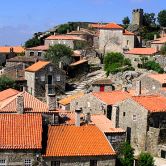Castelo Mendo

Castelo Mendo
Towns and Villages
Built on the top of a hill at a point of great strategic significance, on the remains of earlier fortresses dating back to the Bronze Age and Roman times, Castelo Mendo is a historical village surrounded by walls that were rebuilt in the twelfth century at the orders of D. Sancho I.
In 1229, D. Sancho II ordered the castle to be enlarged and granted the local population a charter to organise a fair, on condition that this was held three times a year. This was the first fair to be held on a regular basis in the whole of Portugal, and in 1281 D. Dinis ordered that this should be a free fair to be held on an annual basis. The fair's original storehouse still exists in the village on the site of what was once the fairground.
The village's name derives from that of the first governor, D. Mendo Mendes, appointed by D. Dinis in the fourteenth century. On one of the walls of the former jailhouse, it is still possible to see a stone sculpture which, according to popular tradition, represents Mendo, whilst on another house nearby one can see a representation of Menda, who was the wife of Mendo. This house is therefore known as the Casa da Menda.
Encircled by walls with six mediaeval gates (the main gate is flanked by two statues of pigs), the village essentially consists of simple stone houses, all of which originally had two storeys, the lower one being used to house the cattle, whilst the upper one was used as a residence. The extremely narrow streets made the village easy to defend, although a number of battles were fought here during the various wars in which Portugal was involved, especially those with the Spanish.
Restoration work has recently begun in the village and it is gradually regaining some of its original features, offering those visitors who venture inside its walls the chance to enjoy a journey into its rich and interesting past.
In 1229, D. Sancho II ordered the castle to be enlarged and granted the local population a charter to organise a fair, on condition that this was held three times a year. This was the first fair to be held on a regular basis in the whole of Portugal, and in 1281 D. Dinis ordered that this should be a free fair to be held on an annual basis. The fair's original storehouse still exists in the village on the site of what was once the fairground.
The village's name derives from that of the first governor, D. Mendo Mendes, appointed by D. Dinis in the fourteenth century. On one of the walls of the former jailhouse, it is still possible to see a stone sculpture which, according to popular tradition, represents Mendo, whilst on another house nearby one can see a representation of Menda, who was the wife of Mendo. This house is therefore known as the Casa da Menda.
Encircled by walls with six mediaeval gates (the main gate is flanked by two statues of pigs), the village essentially consists of simple stone houses, all of which originally had two storeys, the lower one being used to house the cattle, whilst the upper one was used as a residence. The extremely narrow streets made the village easy to defend, although a number of battles were fought here during the various wars in which Portugal was involved, especially those with the Spanish.
Restoration work has recently begun in the village and it is gradually regaining some of its original features, offering those visitors who venture inside its walls the chance to enjoy a journey into its rich and interesting past.
Contacts
Social Networks:
















 Explore
Explore 
 Remember and Share
Remember and Share 


